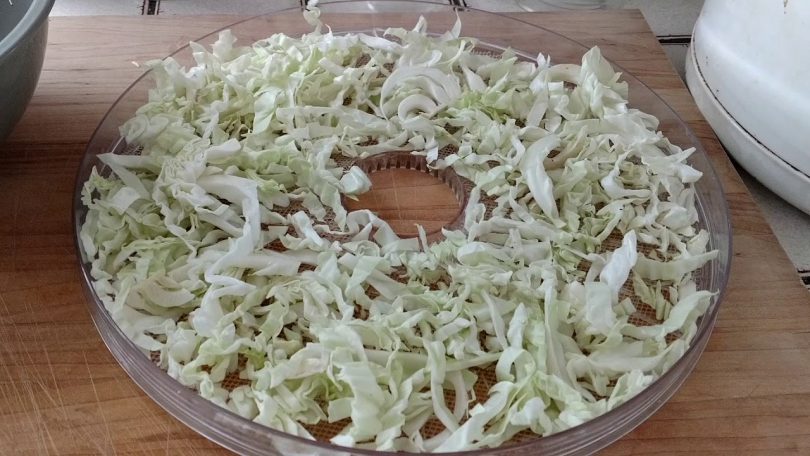Learn how to dehydrate cabbage at home!
Cabbage is a great ingredient for slaws, soups, and stews. When made crispy, it also offers a healthier snack alternative to chips. One way to make sure that you do not run out of the veggie when you need it is to dehydrate and preserve it.
There are various ways to dehydrate cabbage. This way, you can be sure to have a ready supply of dried cabbage when you suddenly feel the craving for some hot soup on a cold night.
The most common way to dry cabbage is through the use of a food dehydrator. However, you don’t have to fret if you don’t have one. No need to buy just yet as there are other alternatives.
Having said that, here are some easy ways to dehydrate cabbage.
How to Dehydrate Cabbage
Using a food dehydrator to dehydrate cabbage
Drying cabbage in a dehydrator is convenient as it doesn’t involve too much work. Some dehydrator models allow drying an entire cabbage head in a single go.
- The first step is to remove the outer leaves that are often tough and do not dry very well. Don’t get rid of them, however, as you can use them for other recipes.
- Rinse the vegetable thoroughly, then slice thinly into strips. Each strip should measure around 1/8” wide.
- Get the dehydrator trays and lay down the cabbage strips. While the strips may overlap a bit, you must see to it that they are laid out – as much as possible – in single layers.
- Place the trays in the dehydrator. Set the temperature at 125 to 135 F. You can also follow the instructions that came with your dehydrator.
- The cabbage strips will completely dry up in about 7 to 11 hours. You will know that they are done when the strips are totally brittle to the touch.
- Rotate the trays a few times during the drying time to dry evenly.
- Check for the desired dryness after every few hours. Once done, remove the trays from the dehydrator and set aside to dry for a few minutes.
When done and completely cooled, transfer the dried veggies to airtight containers like mason jars or vacuum-sealed bags for proper storage. (More on proper storage of dried cabbage later.)
Using an oven to dehydrate cabbage
If you don’t have access to a food dehydrator, or you simply want to try another drying option, you can instead use your oven.
You can forego buying a dehydrator if you don’t intend to dry food very often. After all, you can always just use your oven. Here’s how to do it:
- Similar to using a dehydrator, you begin by cleaning the cabbage.
- Cut the cabbage into about 1/8” strips.
- Line a baking sheet with parchment paper. Lay down the cabbage strips on the pans, as much as possible, in single layers.
- Set the oven to the lowest possible temperature. This is usually 200 to 225 F. Put the pans inside the oven. Check the cabbage strips for dryness after every few hours. The veggies should dry completely in 6 to 11 hours.
For best results, keep the oven door slightly open. This way, moisture can easily escape.
** If you aren’t comfortable with the idea of letting your oven operate that long, you can instead use an oven toaster. However, a toaster won’t allow you to dry as much cabbage in one go since the appliance is much smaller than an oven. You also need to keep an eye on the veggies as burning is more likely when using an oven toaster.
- Once completely dry, remove the cabbage from the oven, and set aside to dry for a few minutes.
Transfer the dried veggies to airtight containers like mason jars or vacuum-sealed bags for proper storage.
Sun-drying cabbage
This is, without a doubt, the most eco-friendly method, and perhaps the easiest way to dry cabbage. However, this will only work if you have lots of sun in your area.
- After cleaning and chopping the cabbage, lay down the strips on cookie sheets. Put the sheets in a place where there is a lot of sun.
- Cover the veggies with cheesecloth to keep bugs away.
- It may take a few days to completely dry the cabbage, depending on the amount of sun.
Once completely dried, store the dehydrated cabbage strips in airtight containers like mason jars or vacuum-sealed bags.
Rehydrating Dried Cabbage
If you are not fond of snacking on dried cabbage, you can rehydrate it, and use it as an ingredient in various recipes. The vegetable rehydrates well, and in no time, you can use it for soups and other recipes.
To rehydrate for use in cooking, use the ratio of ¼ cup of dried cabbage with one cup of water. Adjust it for larger amounts of the dried veggie.
Bring the mixture to a boil. Allow boiling until the cabbage becomes tender. This should take around 15 minutes all in all. Stir from time to time during the rehydration process. Drain the excess water. Season to your preferred taste.
When using the dried cabbage for salads or as an ingredient in a cold dish, just use the same ratio as above, but this time in cold water. Soak the veggie until it softens. If you want the cabbage to be crispier, you can add ice cubes.
How to Store Dehydrated Cabbage
It is crucial that you keep dehydrated cabbage in airtight, food-grade containers. You can also use mason jars or vacuum-sealed bags for the purpose.
SEE ALSO: How to Store Dried Vegetables
However, zip-top storage bags made of plastic, which are very popular, are not a good option simply because they aren’t airtight. They let air get through the zipper top, and through the plastic over time.
While they may do well for short term storage, they aren’t ideal for storing dehydrated cabbage. Moisture must be kept out at all times, and zip-top storage bags aren’t reliable in this aspect. In one or two days, you may notice that your dried cabbage has become soft or chewy.





